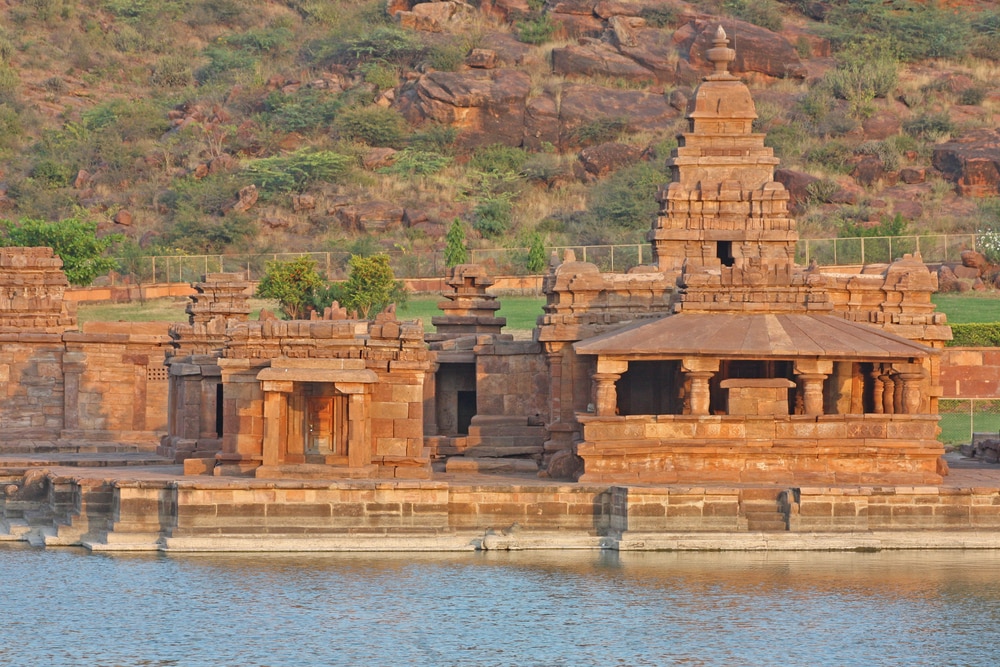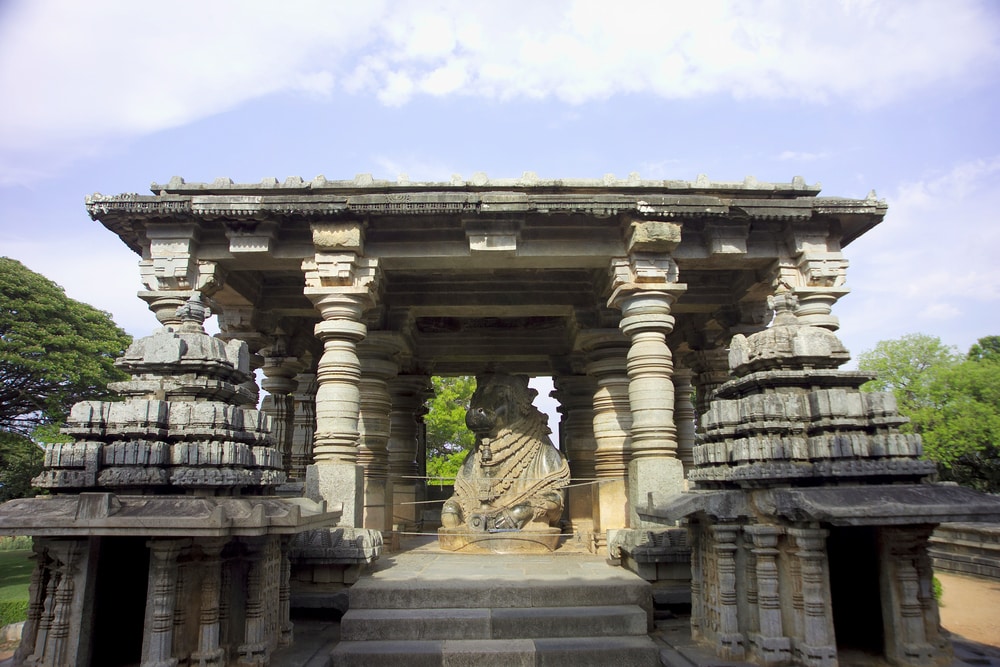Karnataka is a land both ancient and modern – on one hand, it is home to Bengaluru, India’s IT capital, on another hand, it is also home to historic places like Hampi, Aihole, Badami, and Pattadakal, which feature some of the famous UNESCO World Heritage Sites. Temples in Karnataka feature diverse architectural styles like Hoysala, Badami Chalukya, Vijayanagara, Dravidian, Western Chalukya, Badami Cave, Rashtrakuta, and Ganga architecture. Some common features found in most of these temples are – a Nandi bull, a pushkarani (stepped bathing area), one or more gopura (ornate tower), a garbhagudi (inner sanctum), a vigraha (idol), and often some form of a chariot. Other common aspects include that the older temples were built amidst nature, usually on a hilltop, and next to a water body. Some temples, especially in Dakshina Kannada, follow a strict dress code.
Top 16 Temples To Visit In Karnataka
- Murudeshwara Temple
- Badami Cave Temples
- Hoysaleswara Temple
- Virupaksha Temple, Hampi
- Virupaksha Temple, Pattadakal
- Bhutanatha Group of Temples, Badami
- Mahakuta Group of Temples, Badami
- Durga Temple, Aihole
- Sri Krishna Temple, Udupi
- Kotilingeshwara Temple, Kolar
- Sangameshwara Temple, Kudalasangama
- Mallikarjuna Temple, Talakad
- Shiva Statue, Murdeshwar Temple
- Gomateshwara Statue, Shravanabelagola
- Yoga Narsimha Temple
- Mookambika Temple, Kollur
1. Murudeshwara Temple
This temple is located in the scenic town of Murudeshwara in Karnataka, this temple is built on the Kanduka Hill which is surrounded on three sides by the waters of the Arabian Sea. No other temple in the world has such a beautiful installation of a gigantic Shiva statue against the sea, making it one of the most visually appealing temples of Karnataka. Apart from the magnificent statue which is the main attraction for many, the temple complex also has a 20-storey Gopura (fitted with a lift that takes visitors to the top of the structure. The view from the top looks like the image below!)
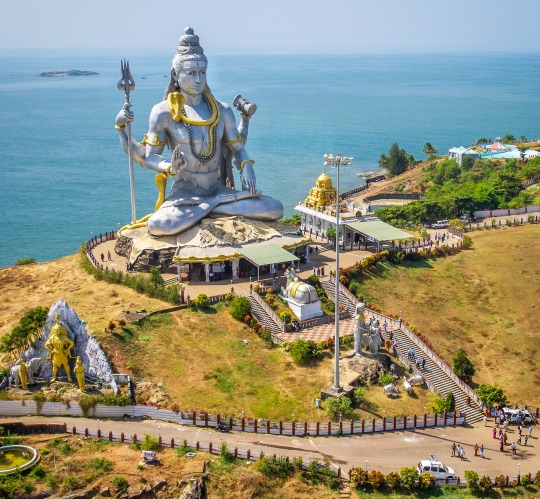
At 123 ft, the temple has the second largest Shiva statue in the world.
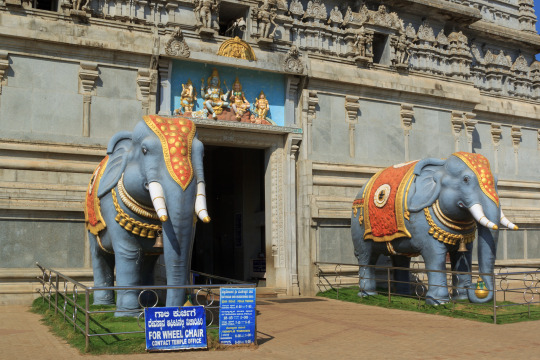
Two life-size elephants in concrete stand guard outside the temple.
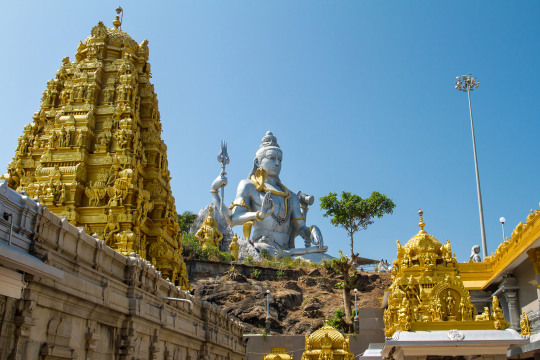
View of the Shiva statue from inside the temple complex.
How to reach –
Murudeshwar is about 450 km by road from Bangalore. One can travel in a KSRTC bus which takes about 11 hours, or a car which takes about 8-10 hours depending on the driving speed and road conditions. Murudeshwar lies close to Bhatkal station on the Konkan Railway route, and there are trains available between Bangalore and Bhatkal. However, most visitors prefer to travel by road as it is more convenient.
2. Badami Cave Temples
The Badami cave temples are a complex of temples located at Badami in northern Karnataka. An example of rock-cut architecture, the temples are spread across four caves. There is also the fifth one, the natural Buddhist cave temple in Badami which can be entered kneeling on all fours. Right next to the temple complex is a small lake known as the Agastya Teertha. The water body together with the rocky temples in the backdrop presents a pretty picture.
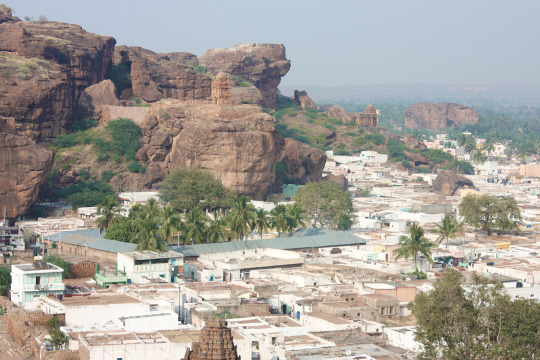
View of the cliff on which the Badami cave temples stand.
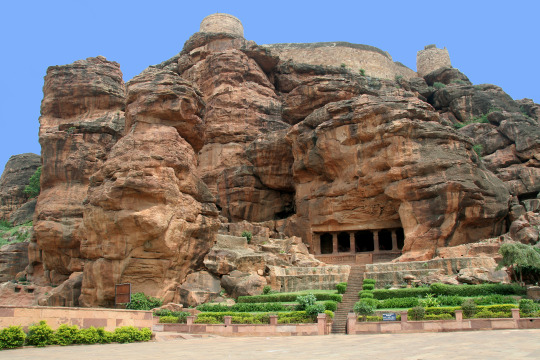
Entry to one of the caves.
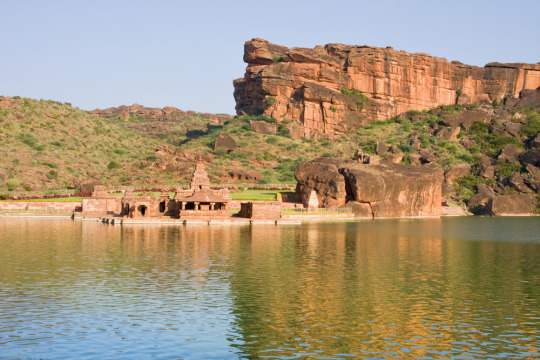
View of the Badami caves and Agasthya Theertha tank
A closer view of the temples
How to reach –
Badami is just 272 km (6 hours) from Panaji in Goa, and this makes it an ideal stopover for those who are traveling to Goa. Bangalore is located at a distance of about 450 km (10 hours) and serves as the nearest metropolitan city. Travelers from far-off locations can route their trip via Bangalore and then take a bus or a car to visit Badami.
3. Hoysaleswara Temple
The beautiful Hoysaleswara temple in Halebidu, Karnataka is a Shiva temple with beautiful carvings. The temple is made of soapstone and is most well known for its sculptures that run all along the outer wall. The intricate carvings on the stone on the walls of this temple are breathtaking, and reason enough to travel to Halebidu. Another interesting feature of this complex is that all the structures have been built on a platform, a style of architecture that began during the Hoysala period.
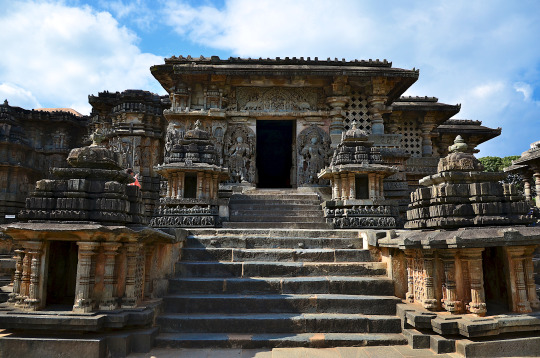
A view of the Hoysaleswara Temple.
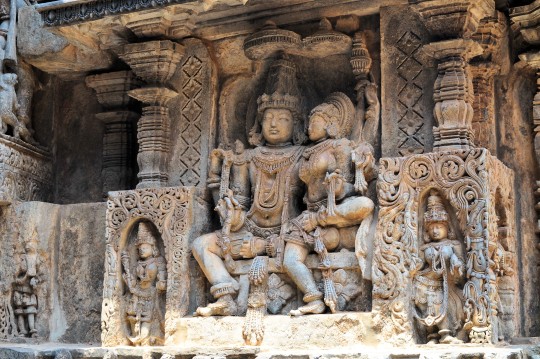
Sculpture on the outer walls of the Hoysaleswara Temple.
Sculpture of Nandi, the bull.
How to reach –
Halebidu is just 149 km from Mysore, another popular tourist destination in Karnataka. Well-connected to Mysore, Hassan and Bangalore, most tourists prefer to travel by road from Bangalore, a distance of just 215 km (4 hours).
4. Virupaksha Temple, Group of Monuments, Hampi
The UNESCO World Heritage Site of the Hampi Group of Monuments is centred around the illustrious Virupaksha Temple on the banks of river Tungabhadra. The Virupaksha-Pampa Sanctuary was one of the ancient religious sites dedicated to Shiva. Later in 7-century, the Virupaksha Temple was built in Vijayanagara architectural style, with Virupaksha as the presiding deity. Every morning, Lakshmi, the temple elephant comes out of her chambers to bathe in the Tungabhadra Channel. A unique feature of this temple is the use of mathematical concepts of fractals displayed in the repeating patterns of its architecture.
Timings: 6:00 AM to 8:00 PM
Entry Fee: INR 5
5. Virupaksha Temple, Group of Monuments, Pattadakal
A UNESCO World Heritage Site, the Group of Monuments at Pattadakal refers to a complex of 7-century and 8-century Hindu and Jain temples on the banks of river Malaprabha. The largest amongst these is the Dravidian style Virupaksha Temple, also regarded the most sophisticated monument. The temple is adorned with friezes depicting scenes and deities from the Vedic era, Mahabharata, Bhagavata Purana, Ramayana, and Panchatantra. Carvings on the sanctum walls are considered the most intricate and detailed of the early Chalukya monuments. In the sanctum sanctorum, an idol of the Nandi bull sits facing a Shiva lingam, the presiding deity.
Timings: 6:00 AM to 9:00 PM
Entry Fee: INR 30
6. Bhutanatha Group of Temples, Badami
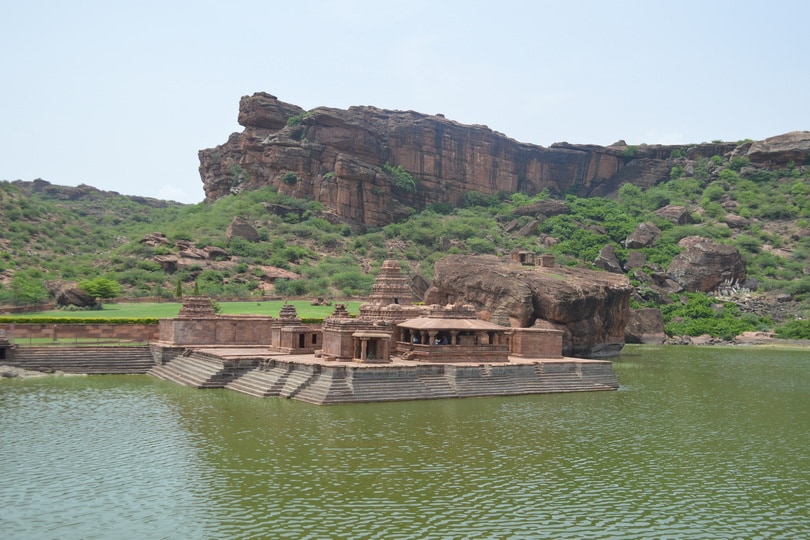
This beautiful pilgrimage site refers to a cluster of sandstone temples sprawling next to the man-made lake Agastya in Badami. The two main temples here are the Bhutanatha and Mallikarjuna temples, lying on the east and north-east side of the lake respectively. The Bhutanatha Temple features architectural styles from different periods – its 7-century inner mandapa (hall) was built by Badami Chalukyas rulers and the 11-century outer mandapa by Kalyani Chalukyas. Featuring a blend of both South Indian and North Indian style, its outer mandapa extends into the lake. The Mallikarjuna Temples exhibit topological features through its plain walls, stepped superstructures, and angled eaves.
7. Mahakuta Group of Temples, Badami
Built during the early Chalukya dynasty, the group of temples at Mahakuta is renowned as a Shaiva monastery. Artisans combined the Dravida and Nagara architectural styles in these temples, marking the beginnings of Vesara style of architecture. The temples are noted for two inscriptions – a Sanskrit and Kannad inscription dated 595–602 CE on the Mahakuta Pillar, and a Kannad inscription on Mahakuteshvara Temple’s porch. A natural spring flows within the complex and feeds into the two temple tanks. The shrines of Mahakuteshvara and Mallikarjuna are the largest. A small shrine of the panchamukha (five-headed) Shiva lingam is erected in the middle of one of the water tanks.
Timings: 6:00 AM to 6:00 PM
8. Durga Temple, Aihole
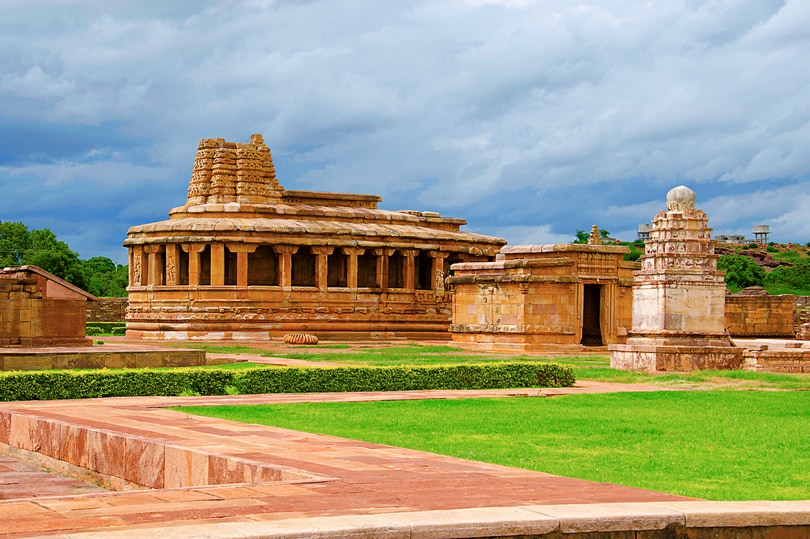
An archaeological expedition at Aihole led to the discoveries of the Pattadakal monuments, a UNESCO World Heritage Site. Aihole itself is a historical and archaeological goldmine, featuring over 121 stone and cave temples dated 4-century to 12-century. Of these Hindu, Jain, and Buddhist monuments, the Durga Temple is probably the largest. Mostly built in the 7-century by the Chalukya Dynasty, it features a dravida and nagara architectural style. The most striking aspects are the oblong and apsidal plan of the temple, and the intricately carved peristyle running around it. Numerous representations of Shiva and Vishnu are featured in the temple.
Timings: 10:00 AM to 5:00 PM
Entry Fee: INR 5
9. Sri Krishna Temple, Udupi
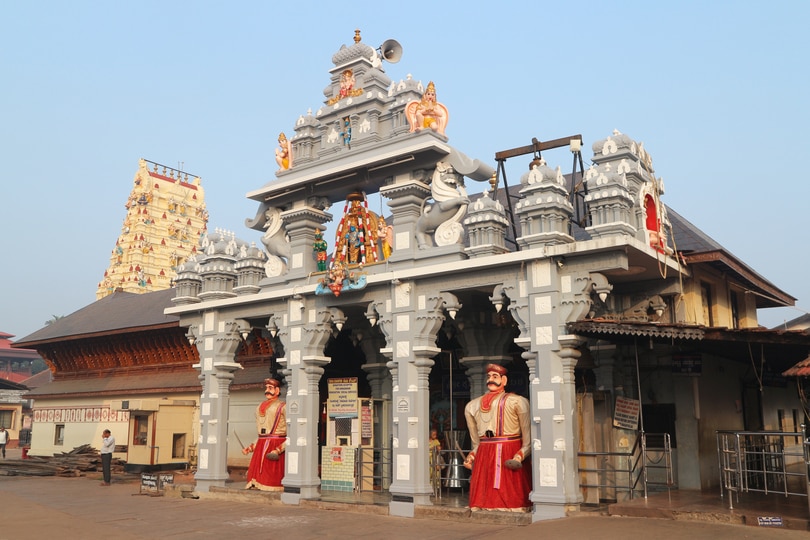
The 13-century Sri Krishna Temple was established by Vaishnavite sage Madhwacharya who founded the Dvaita school of Vedanta. As per legend, the statue of Krishna in the sanctum sanctorum was found by Madhwacharya in a large gopichandana ball. This statue can be viewed through the Navagraha Kindi, which is often mistaken with the Kanakana Kindi (Kanaka’s Window) – a tiny peephole in the temple wall to see through and view the sage Kanaka Dasa’s statue. One of the most revered temples in Karnataka, it is also the centre of Daasa Sahitya – the literature of the Bhakti movement, which originated in Udupi.
Timings: 4:00 AM to 9:00 PM
Entry Fee: Free
10. Kotilingeshwara Temple, Kolar

The Dravidian style Kotilingeshwara Temple features one of the world’s largest lingam. But contrary to popular belief, the main attraction of this temple is not only its 108-feet tall lingam, but the other, lakhs of smaller, colourful lingams surrounding it, and a 35-feet tall Nandi bull idol facing it. Lord Shiva is worshipped in the form of Kotilingeshwara, the presiding deity of this temple. Additionally, the complex houses eleven smaller temples dedicated to various deities. A water tank near the lingam is used for performing the abhishek (cleansing) ritual. The complex also has a rest house, a meditation hall, an exhibition centre, and a marriage hall.
Timings: 6:00 AM to 9:00 PM
Entry Fee: INR 20
11. Sangameshwara Temple, Kudalasangama
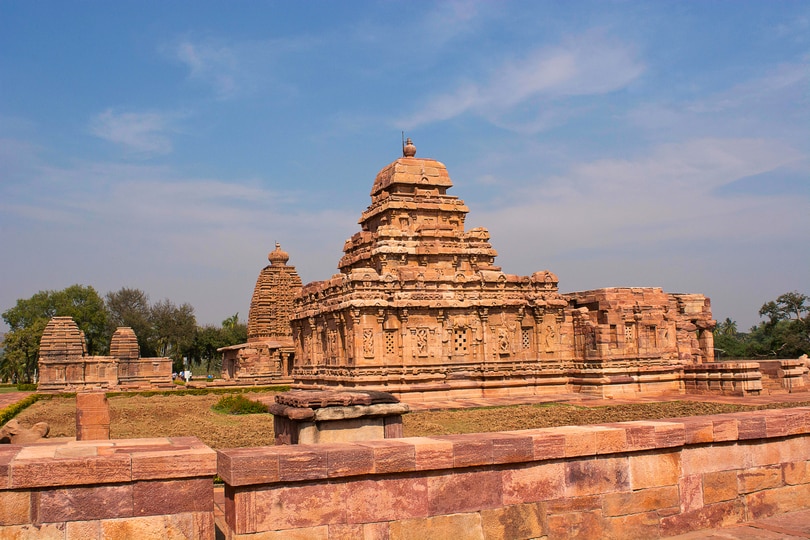
Both Sangameshwara and Kudalasangama – the name of the temple and the place, bear the word ‘sangam’ in them, which means ‘confluence’. Located at the confluence of rivers Krishna and the Malaprabha, this magnificent temple features Chalukya architectural style. Sangameshwara is a renowned pilgrim center for Aikya Mandapa – the shrine of Kannad poet Basavanna, founder of the Lingayat sect. A swayambhu lingam (self-manifested Shiva idol) in the sanctum sanctorum is worshipped as Sangameshwara, the presiding deity. The temple has a porch, a navagraha (hall with 9 bays), the main shrine, and inscriptions dated the early 12-century. Another small lingam stands on a mandapa (base) amidst the river in front of the temple.
Timings: 5:00 AM to 12:30 PM, 4:00 PM to 8:00 PM
Entry Fee: Free
12. Mallikarjuna Temple, Talakad
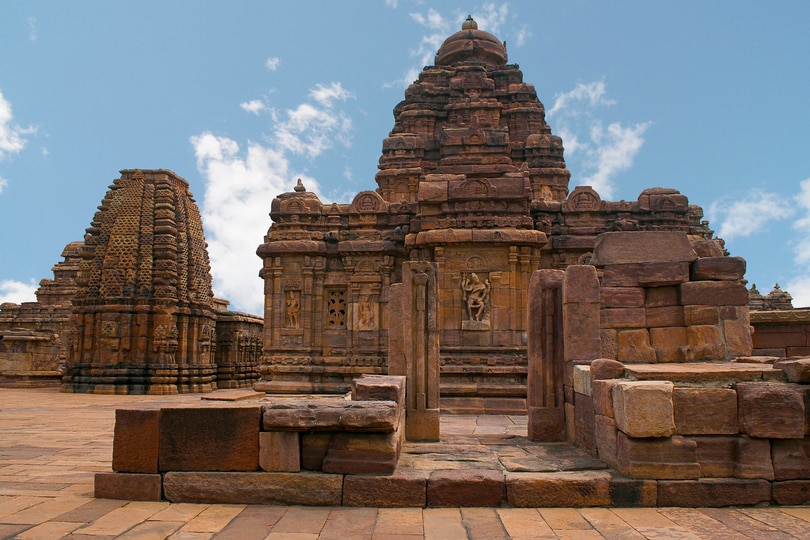
Muduku means ‘diversion’ and thore means ‘ to flow forward’ – which refers to the change in direction of river Cauvery at Mudukuthore, a pilgrim center lying on its banks. Legend goes that warrior king Arjuna lived on the Somagiri Hill and prayed to Lord Shiva with mallika-pushpa (jasmine) flowers, giving this Shiva temple its name Mallikarjuna. It is one of the five temples that celebrate the festival of Panchalinga Darshana – a sight of the five lingams – held at Talakad every 12 years. A unique aspect of the festival is that all the prayers, rituals and ceremonies begin simultaneously at the five temples.
Timings: 8:00 AM to 6:00 PM
Entry Fee: Free
13. Murdeshwar Temple
A 123-feet tall Shiva statue sitting in a lotus position atop a small hill, adjacent to a 237-feet tall gopura (tower), with both structures surrounded by the Arabian Sea in the backdrop – this striking imagery is part of the Murdeshwar Temple complex, one of the most enchanting religious sites in Karnataka. The most stunning views of the Shiva statue are watched aboard the lift in the 20-storied Rajagopura building. Another unique feature is the temple’s presiding deity, Mridesa lingam, which is believed to be an original part of the Atma Linga (Shiva’s soul). The temple complex houses many other shrines and statues.
Timings: 6:00 AM to 1:00 PM, 3:00 PM to 8:30 PM
Entry Fee: Free
14. Gomateshwara Statue, Shravanabelagola
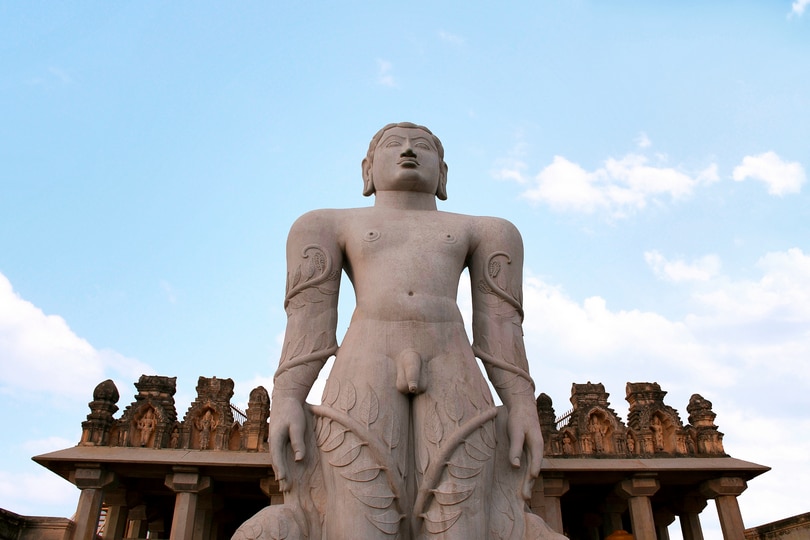
The renowned statue of Gommateshwara is a 57-feet tall monolithic sculpture located on Vindyagiri Hills in Shravanabelagola. This 10-century statue was built under the Ganga Dynasty. Dedicated to Bahubali, a prominent Jain figure, it is the world’s biggest free-standing statues. Bahubali stands in kayotsarga (standing still) pose, a faint smile, and partly-open eyes. An anthill in the backdrop signifies the passage of time. A snake and creeper emerge from the anthill, twine around the statue’s legs and arms, and protrude out of the arms as flowers and berries. The whole figure stands on an open lotus, with two richly carved sculptures on both sides, which represent the yaksh and yakshini (attendees).
Timings: 6:30 AM to 11:30 PM, 3:30 PM to 6:30 PM
Entry Fee: Free
15. Yoga Narsimha Temple, Melukote
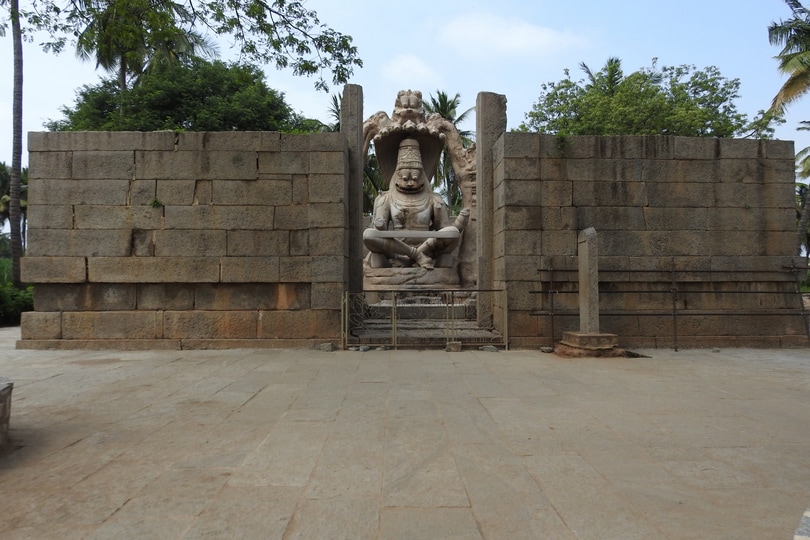
Melukote is home to two revered temples of Karnataka – the ancient Cheluvanarayana Swamy Temple, and the hilltop Yoga Narsimha Temple. Featuring a Dravidian architectural style, the Yoga Narsimha Temple is regarded as one amongst the seven sacred centres dedicated to Narasimha, a form of Lord Vishnu. The Narasimha idol is seated wearing a yogapatta. The temple houses many valuable items received as a gift – a huge drum donated by Tipu Sultan, a beautiful bell donated by Mysore’s Parakala Matha, and a gold crown for the temple deity donated by the Wodeyar Kings of Mysore. As per legend, the temple finds mention in ancient Vedic literature.
Timings: 9:00 AM to 1:00 PM, 5:30 PM to 8:00 PM (Saturdays and Sundays) 11:00 AM to 2:00 PM, 5:00 PM to 8:00 PM
Entry Fee: Free
16. Mookambika Temple, Kollur
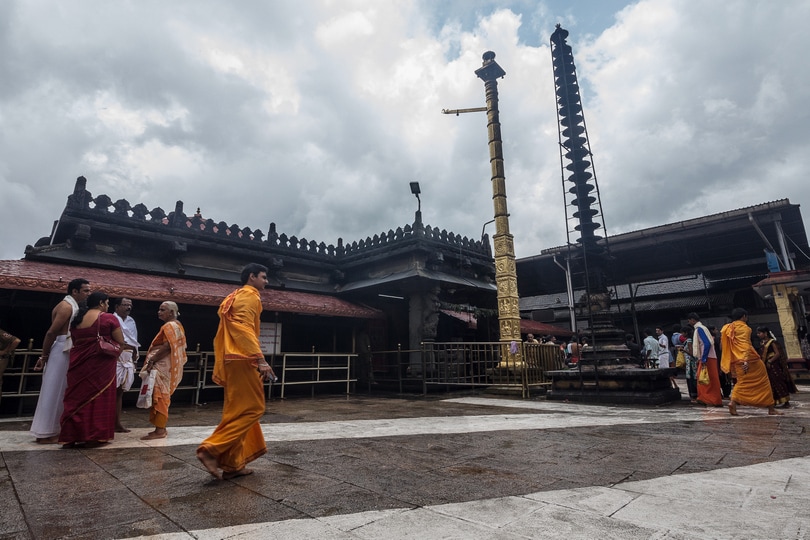
The Mookambika Temple lies in the foothills of Kudajadri Hills in Kollur, on a land believed to be created by sage Parashurama. One of the most illustrious temples of Karnataka, it holds a special bond with Keralites as it features amongst the 108 Durga and 108 Shiva temples in Kerala. It houses a four-armed panchaloha (five metals) idol of Goddess Mookambika. The presiding deity is a swayambhu (self-born) jyotirlinga through which passes a golden line splitting the lingam into half – the left half symbolizes tridevis and the right half symbolizes trimurtis.
Timings: 5:00 AM to 1:30 PM, 3:00 PM to 9:00 PM
Entry Fee: Free
Other religiously significant temples in Karnataka include Bhagandeshwara Temple at Triveni Sangam, Sharada Peetham at Sringeri, Kukke Subramanya, Mahabaleshwar Temple at Gokarna, Male Mahadeshwara Temple at Betta, Durgaparameshwari at Kateel, and others. Some architectural masterpieces are found in the hilltop shrine of Baba Budangiri in Chikkamagaluru, Bucesvara Temple in Koravangala, Keshava Temple in Somanathapura, Doddabasappa Temple at Dambal, and the Bettada Byraveshwara Temple. Origins of the Lingayat sect and Dvaita school of thought are traced to Karnataka, the land where multiple religions flourished. Over a thousand temples stand testimony to the rich history, literature, architecture, and culture of Karnataka.
More: Take a Spiritual Tour of the Temples in Mangalore
OYO Explorer Tip – Rather than planning a standalone visit to this town, going for a week-long tour of Karnataka with this town as one of the stopovers will probably be a better option for those traveling from distant locations. One can stay comfortably at any of the OYOs in Bangalore, Mysore or Mangalore to avoid burning a big hole in the pocket. Once there, one can plan out visits to different places such as Murudeshwar, Badami and Halebidu to explore the temples of Karnataka. This blog post does not mention exotic Hampi as that will be the subject of another, more detailed blog on the temples of Karnataka. Happy exploring!
P.s. You might like these related resources:
- Presenting Lucknow’s mouthwatering Awadhi cuisine - February 25, 2019
- 35 Yummilicious Foods To Definitely Try In Leh Ladakh- Food that you should not miss - January 24, 2019
- 35 Important Religious Places In India That Are A Must-Visit For Devotees - January 23, 2019
- Snaps from Lonavala – A captivating photo-blog - December 17, 2016
- India Surf Festival 2016 - October 27, 2016
- OYO StayOut – Anytime, Anywhere, Any Price Stays - October 22, 2016
- How India slays life’s evils through travel - October 17, 2016
- This Couple Goes On A Trip To Goa Every Year And They Don’t Plan To Stop - September 19, 2016
- 17 Unexplored Beaches of Goa To Visit Right Now - September 17, 2016
- Behind The Scenes – The Making of Ganesha - September 5, 2016


